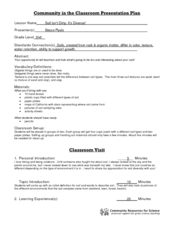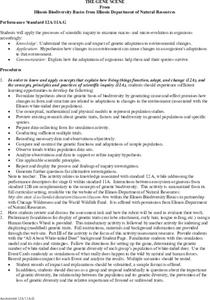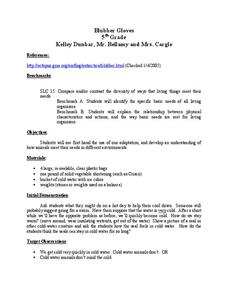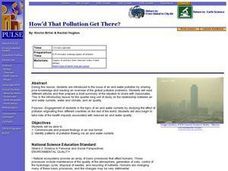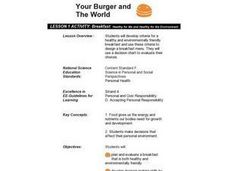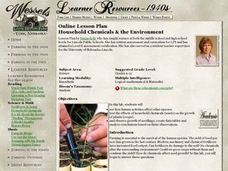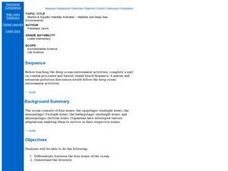Curated OER
Soil Isn't Dirty; It's Diverse!
Second graders participate in a soil activity. In this soil instructional activity students complete a worksheet describing different soil types and the organic and inorganic things found in them.
Curated OER
Make Bark and Leaf Rubbings
Young scholars explore natural resources by creating art from plant materials. In this leaf rubbings lesson, students identify the plants that shed bark and leaves and discuss how it helps them survive in specific environments. Young...
Curated OER
Plot Studies
Third graders are introduced to how to properly read a plot map. As a class, they take a field trip to an area surrounding the school and work together in groups to examine small sections of the different environments. To end the...
Curated OER
The Gene Scene
High schoolers investigate the concepts of micro and macro evolution. They also research the effects of mutations in the process of genetic adaptation to different environments. They develop a hypothesis of how the environment can...
Curated OER
Blubber Gloves
Fifth graders examine animal adaptations and how they meet their needs in a variety of environments. They discuss how they might adapt to their own environment before discussing how an animal could adapt. Next, they complete an...
Curated OER
Reading
High schoolers participate in a jungle run in which they must group with the same people who hold the same cards with pictures of a tree, mushroom, deer or insect. In these groups, they read the definitions of sustainable development. ...
Curated OER
Which Sand Contains The Most Salt?
Students investigate the salinity levels of sand samples taken from several different sources. They conduct tests and observations to measure the current salt levels. They develop a hypothesis from the experiment to determine the factors...
Curated OER
Thinking About Science and the Environment
Pupils read 3 or 4 Science articles and complete a chart. In this scientific thought concept instructional activity, students play a game using their chart to reinforce their ideas and concepts. Pupils make a list of the bigger ideas...
Curated OER
INDUSTRY AND THE ENVIRONMENT
Seventh graders create a final project called Industry X (which was previously researched in the unit) has plans to build in town. There is a special town meeting scheduled to discuss this matter and allow everyone to express their...
Curated OER
Environment: How'd That Pollution Get There?
Young scholars examine how global wind and water patterns aid in the spread of worldwide pollution. In groups, they read articles about the domino effect of pollution and create posters displaying its journey. On blank world maps,...
Curated OER
The Living Environment
Sixth graders show what they know about plant and animal cells. In this cell project lesson, 6th graders get to choose a project based on their learning style. They can create a visual representation of cells, auditory forms, or build a...
Curated OER
Breakfast: Healthy for Me and Healthy for the Environment
Students develop criteria for a healthy and environmentally friendly breakfast and use these criteria to design a breakfast menu. They use a decision chart to evaluate their choices which is imbedded in this plan.
Curated OER
Household Chemicals & the Environment
High schoolers conduct a laboratory experiment designed to investigate the effects of chemicals, soil quality and pollution on seed growth and plant yield. They consider how best to maximize agriculture in the long term.
Curated OER
Environment Debate Game
Students participate in a role-play activity to discuss environmental problems on which they have previously conducted research.
Curated OER
Habitats and Deep Sea Environments
Students examine and identify the characteristics of the four zones of the ocean. They discover the amount of diversity in marine habitats. They also explore the adaptations organisms have that have allowed them to survive.
Curated OER
The Living Environment
Students explore the cycles of an ecosystem. In this environmental science lesson, students work in groups to research the nitrogen cycle, the water cycle, or the oxygen-carbon dioxide cycle. Students prepare a PowerPoint or other...
Curated OER
Media Stereotypes: How Differences Divide
Students differentiate between generalizations and stereotypes and compare and contrast gender representation. Finally, they critically analyze media for gender stereotypes. They look at magazines and create collages to focus in on the...
Curated OER
Yeast Cells and their Environment
Students study the scientific method and explore how to design an experiment. In this investigative lesson students explore and hypothesis an experiment then carry it out to find the results.
Curated OER
Applied Science - Built Environment Pre Lab (Morse Code)
Students study communication. In this telegraph lesson, students examine Morse code and the composition of an elementary telegraph circuit. They listen to a presentation and try to create Morse Code messages on a worksheet. This lesson...
Curated OER
Comparing the Similarities and Differences of Medieval Castles
Students compare and contrast a Japanese castle with a Welsh castle. In groups, pupils use the internet to research specified topics on a castle. They explore the government, construction and military function of the area. Classmates...
Curated OER
Peru Geography and the Environment
Fourth graders draw maps of Peru and examine how Peru is a geographically diverse country.
Curated OER
Applied Science- Built environment Lab (Trains)
Learners examine transportation. In this train design lesson, students study how trains work and how to efficiently design a track by working with an electric train set. As a class they compare various types of trains and work...
Curated OER
Integrating Physical Science and the Geological Environment
Students undertake a series of experiments and activities related to geology, especially in Connecticut. They evaluate types of rocks, minerals, and crystals, exploring the main concepts of geology.
Curated OER
Simple Machines, Engines and the Environment
Students examine and describe the six main simple machines. In groups, they work with an inclined plane to calculate the ideal and actual mechanical advantages of the plane. Using their results, they must determine the efficiency of the...


